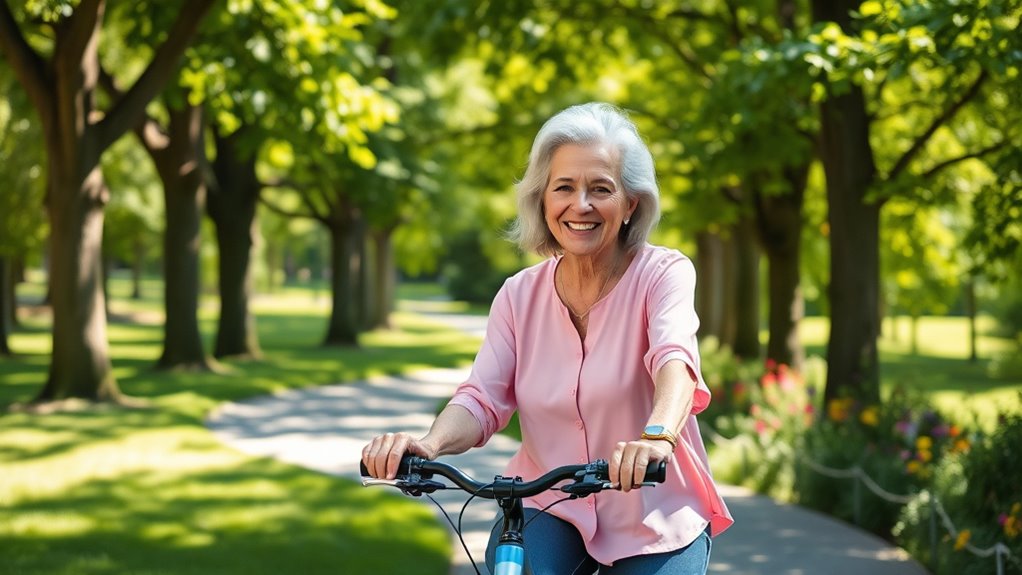Cycling is a great way for seniors to stay active, improve mental health, and enjoy social connections. It boosts mood, reduces stress, and enhances overall well-being through regular activity. Choosing the right bike, planning safe routes, and practicing balance exercises can make your rides more enjoyable and secure. Engaging in group rides and exploring local trails foster community and motivation. Keep exploring these tips to sustain your passion for cycling and embrace a healthier, happier lifestyle.
Key Takeaways
- Cycling boosts mental health, reduces stress, and enhances cognitive function for seniors.
- Choose comfortable, well-fitted bikes with safety gear and plan routes with low traffic and good lighting.
- Incorporate balance exercises and start with flat, safe routes to build confidence and prevent falls.
- Join local cycling groups or community rides to stay motivated and socially engaged.
- Use adaptive equipment and set achievable goals to maintain motivation and enjoy long-term health benefits.
Benefits of Cycling for Older Adults

Cycling offers numerous benefits for older adults, helping to improve overall health and well-being. One key advantage is its positive impact on mental health. Regular cycling can reduce stress, boost mood, and enhance cognitive function, keeping your mind sharp as you age. Additionally, cycling encourages social engagement. Joining group rides or cycling clubs creates opportunities to connect with others, combat loneliness, and build a supportive community. These social interactions foster a sense of belonging and purpose, which are essential for emotional health. Moreover, incorporating tuning options into your cycling routine, such as adjusting bike settings for comfort, can make rides more enjoyable and tailored to your needs. Proper bike maintenance also ensures safety and prolongs the lifespan of your equipment. Engaging in safe cycling practices is crucial for minimizing risks and ensuring a positive experience. Furthermore, cycling is a low-impact activity, making it accessible and safe for many seniors. By incorporating cycling into your routine, you can enjoy improved mental well-being and develop meaningful social connections, enriching your life in numerous ways.
How to Choose the Right Bicycle for Seniors
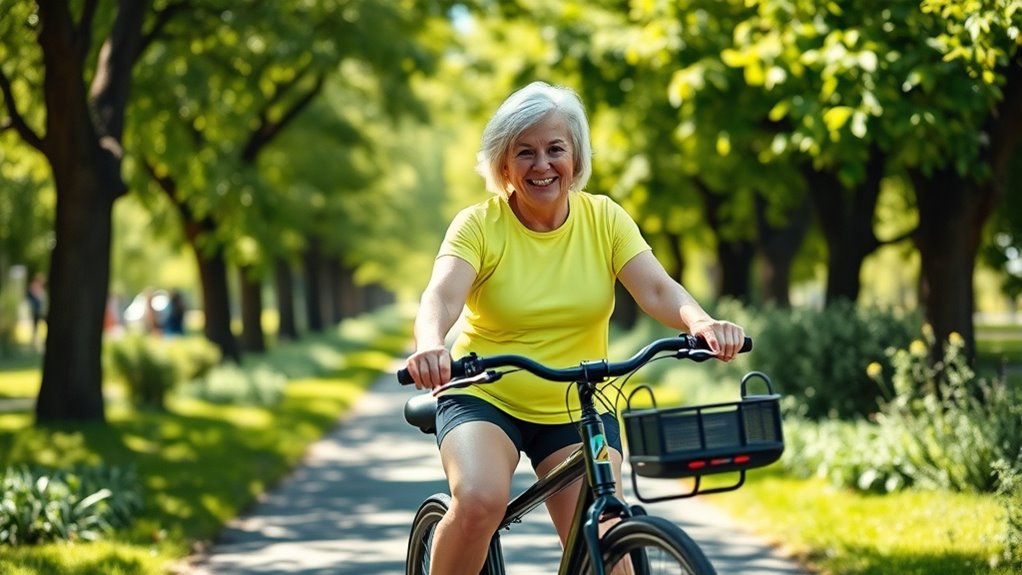
Choosing the right bicycle is essential for ensuring safety, comfort, and enjoyment as you start cycling. Look for a bike with a sturdy frame and appropriate size to match your height and reach. Consider models with step-through frames for easier mounting and dismounting. Think about bike accessories like comfortable grips, a reliable bell, and good lighting to enhance safety. Your riding techniques will be more effective on a bike that feels natural and stable. Test different styles, such as upright or low-step bikes, to find what suits your posture and comfort preferences best. Additionally, selecting a bike with high-quality components can improve durability and riding experience, especially when considering frames and parts designed for reliability and longevity. When shopping, prioritize bikes that feature ergonomic designs to reduce strain and increase comfort during longer rides. Ensuring your bike has appropriate gearing can also make pedaling easier on varied terrains, making your rides more enjoyable and less tiring. Incorporating ergonomic features can significantly reduce fatigue and discomfort, enhancing your overall riding experience.
Preparing for Safe and Enjoyable Rides
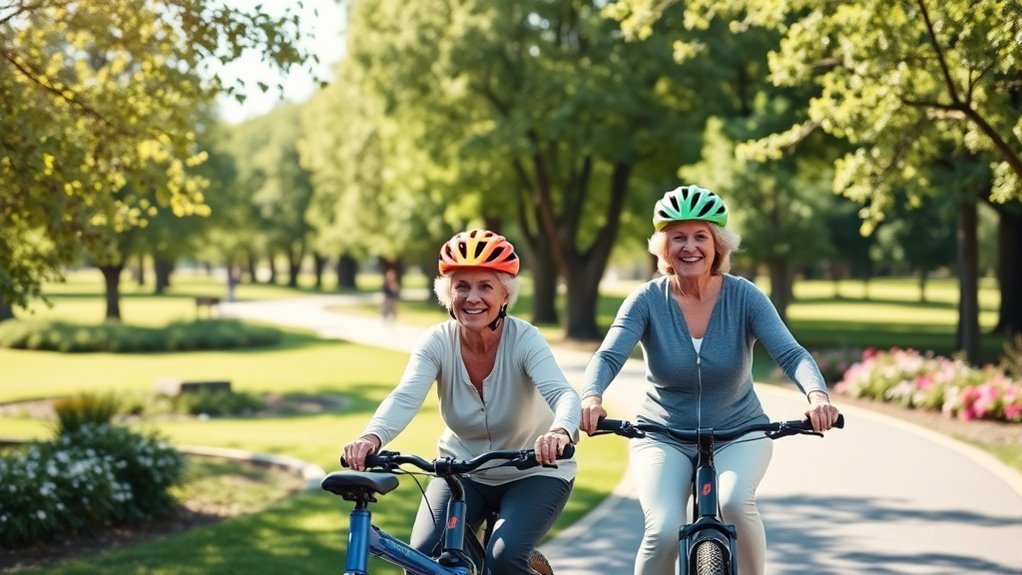
Before heading out, make sure to check your bike for any issues and verify it’s in good working condition.
Wear proper safety gear like a helmet and comfortable clothing to protect yourself and stay visible.
Planning safe routes helps you avoid busy roads and find enjoyable, stress-free rides.
Being aware of your route cost and expenses can help you plan better and stay within your budget.
Additionally, understanding self watering plant pots can inspire you to create low-maintenance gardening solutions that require less frequent watering, making outdoor activities more relaxing.
Incorporating safety strategies into your routine can further enhance your confidence and enjoyment during rides.
Utilizing advanced automation technologies in your bike maintenance routine can help detect issues early and ensure your bike remains reliable.
Regular maintenance and checks can improve your vacuum cleaner performance, ensuring a smoother and safer cycling experience.
Check Your Bike
Have you ever wondered if your bike is truly ready for a safe and enjoyable ride? Starting with bike maintenance is key—check the tires for proper inflation and look for any cracks or worn spots. Inspect the brakes to ensure they respond smoothly and stop effectively. Don’t forget to examine the chain and gears; clean and lubricate them regularly for smooth gear selection. Test your gear shifting to make sure it’s responsive and accurate. A quick overall check can prevent breakdowns or accidents mid-ride. Adjust the seat height so you’re comfortable and have good control. Taking these simple steps guarantees your bike is safe, reliable, and ready to support your active lifestyle. Proper maintenance and gear selection make every ride enjoyable and safe. Fostering a digital-friendly environment at home can also help you share safety tips and maintenance routines with family members, encouraging collective responsibility for bike upkeep. Additionally, ensuring your headphones are functioning correctly can enhance your riding experience, whether for listening to music or staying connected while on the move. Regularly checking your bike’s components ensures optimal performance and longevity of your bicycle, especially when considering glycolic acid benefits for skin, which can help maintain your skin’s health after outdoor rides. Also, understanding the signs of spoilage in lemon juice can be useful for preparing homemade energy drinks or snacks for your rides.
Wear Proper Gear
Ensuring you wear proper gear is the final step in preparing for a safe and enjoyable ride. Start with appropriate footwear—sturdy, comfortable shoes with good grip help maintain control and prevent slips.
Wearing a helmet is essential to protect your head in case of falls. Protective gear is crucial for minimizing injury risks during cycling.
Consider weather considerations: dress in layers for cold days or wear moisture-wicking fabrics in hot weather. Bright or reflective clothing improves visibility, especially in low-light conditions. Using properly fitted gear enhances safety and comfort during your rides.
Incorporating natural materials like linen or cotton in your clothing can also improve breathability and comfort. Gloves can protect your hands and improve grip, while sunglasses shield your eyes from sun and debris.
To further enhance safety, consider cycling accessories such as lights and bells to alert others and increase visibility. Don’t forget to carry a small repair kit and water bottle.
Additionally, staying aware of AI safety developments can help you understand emerging risks and safety measures related to technology that might impact your cycling experience. Proper gear not only keeps you safe but also makes your ride more comfortable and enjoyable. Being prepared ensures you can focus on the ride ahead.
Plan Safe Routes
How can you make your bike rides safer and more enjoyable? Start with route planning. Choose routes that are flat, well-lit, and have bike lanes or low traffic. Avoid busy streets and unfamiliar areas that may pose risks.
Before each ride, do bike maintenance—check tire pressure, brakes, and gears to ensure everything runs smoothly. Planning your route ahead of time helps you stay on familiar paths and avoid surprises. Carry a map or use a GPS app tailored for cyclists.
Inform someone of your route and expected return time. By preparing properly, you reduce hazards and increase confidence. Incorporating emergency preparedness essentials into your riding routine can help you respond effectively to unexpected situations. With thoughtful route planning and regular bike maintenance, your rides become safer, more comfortable, and more enjoyable, encouraging you to stay active and healthy.
Tips for Maintaining Balance and Stability

To stay balanced on your bike, focus on strengthening your core muscles, which provide essential stability.
Make sure your bike fits properly to prevent strain and improve control.
Additionally, practicing balance exercises outside of cycling can boost your overall stability and confidence.
Strengthen Core Muscles
Building strong core muscles is essential for maintaining balance and stability while cycling, especially for seniors. When your core is stable, you improve your posture and reduce the risk of falls.
Incorporate simple exercises like planks, seated marches, or gentle abdominal crunches into your routine. These activities target your core stability, helping you stay upright and confident on your bike.
Consistent core strengthening also alleviates strain on your back and enhances overall coordination. Remember, even short, daily sessions can make a significant difference.
Focus on controlled movements and proper breathing. Strengthening your core isn’t just about fitness; it’s about creating a solid foundation for safer, more comfortable cycling as you age.
Keep at it, and you’ll notice improved balance and posture in no time.
Use Proper Bike Fit
Ensuring your bike fits properly is essential for maintaining balance and stability while cycling. Start by adjusting your bike saddle so it’s level and at a height where your legs have a slight bend at the bottom of each pedal stroke. This position helps you stay steady and reduces strain on your knees.
Pay attention to your pedal position; they should be aligned with your hips to promote smooth pedaling and prevent wobbling. A well-fitted bike keeps your center of gravity low and helps you feel more confident on the road.
Regularly check and fine-tune these adjustments to match your comfort and mobility. Proper bike fit minimizes discomfort and enhances your ability to stay balanced, making every ride safer and more enjoyable.
Practice Balance Exercises
Practicing balance exercises can substantially improve your stability and confidence on the bike. By strengthening ankle stability and enhancing visual awareness, you reduce the risk of falls.
Here are four effective exercises:
- Single-leg stands: Balance on one foot for 30 seconds, then switch. Focus on keeping your ankle stable.
- Heel-to-toe walk: Walk in a straight line, placing heel directly in front of toes. This improves coordination and balance.
- Tai Chi or yoga: Incorporate slow, controlled movements that boost ankle stability and spatial awareness.
- Focus drills: Practice tracking moving objects with your eyes to sharpen visual awareness, helping you react swiftly while cycling.
Consistent practice enhances your overall stability, making cycling safer and more enjoyable.
Incorporating Cycling Into Your Weekly Routine
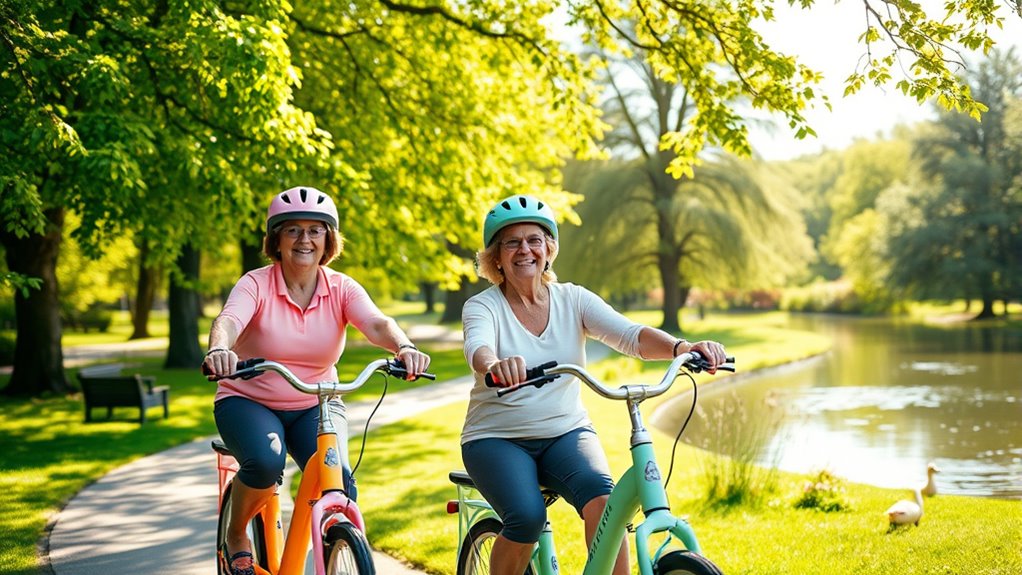
Adding cycling to your weekly routine can be a simple and enjoyable way to stay active and improve your health. Start by setting realistic goals, like cycling three times a week for 30-minute sessions.
Incorporate cycling into your weekly routine with achievable goals for better health and enjoyment.
Invest in essential cycling accessories, such as comfortable helmets, reflective gear, and lights, to stay visible and safe. Before each ride, perform quick bike maintenance checks—ensure tires are properly inflated, brakes work well, and the chain is lubricated.
Planning routes in safe, scenic areas can boost your motivation. Incorporate variety by exploring different paths or adjusting intensity.
Keep a schedule, and gradually increase your distance and duration. Making cycling a regular habit will help you enjoy its physical and mental benefits while fitting easily into your weekly routine.
Safety Gear and Precautions for Seniors
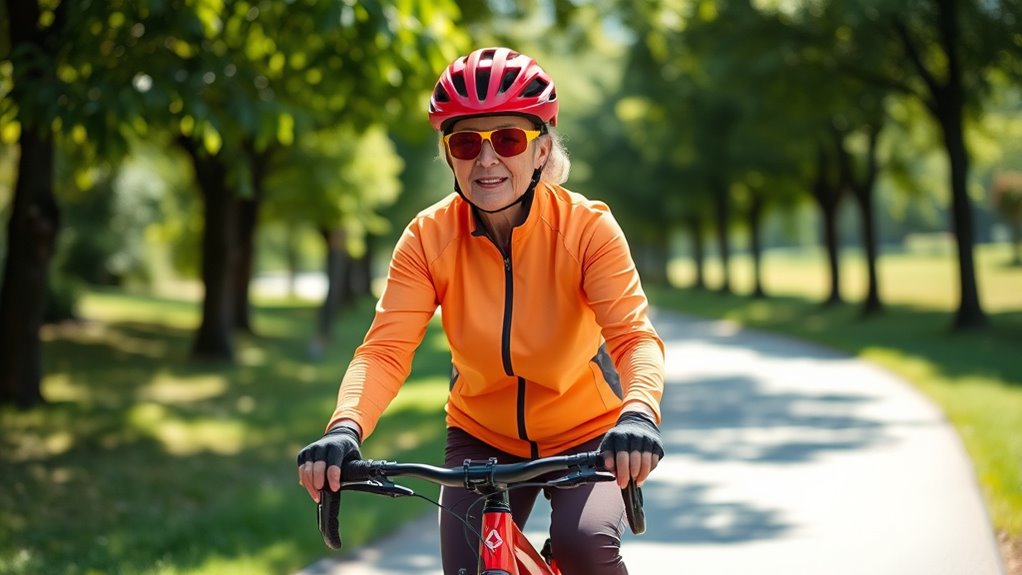
Ensuring your safety starts with wearing a properly fitting helmet that stays secure during your ride. You should also wear reflective clothing to stay visible, especially in low-light conditions.
Regularly checking your bike for loose parts and proper function helps prevent accidents before they happen.
Proper Helmet Fit
A properly fitting helmet is essential for keeping seniors safe while cycling. When it comes to helmet safety, a helmet that doesn’t fit correctly can be ineffective. Here are four tips to guarantee proper fit:
- Measure your head to find the correct size, usually using a soft measuring tape around the widest part of your head.
- Adjust the straps so they sit snugly below your ears and form a V under your jaw.
- Ensure the helmet sits level on your head, covering your forehead without tilting back or forward.
- Perform the shake test—gently shake your head to confirm the helmet stays in place without shifting.
Reflective Clothing Usage
Wearing reflective clothing is one of the most effective ways for seniors to stay visible and safe while cycling, especially during low-light conditions. Reflective clothing and visibility gear guarantee that drivers and pedestrians can see you from a distance, reducing the risk of accidents.
Choose bright, reflective vests or jackets designed specifically for cyclists, and wear them prominently on your rides. Attach reflective strips to your bike and helmet for added safety.
Make sure your clothing is comfortable and fits well, so it doesn’t distract or hinder your movement. Proper use of visibility gear helps you stand out on the road, giving you peace of mind and allowing you to enjoy your ride confidently.
Staying visible is a simple, essential step to safer cycling in later years.
Regular Safety Checks
How often do you check your safety gear before heading out on a ride? Regular safety checks are crucial for safe cycling, especially for seniors. Keep your bike maintenance up to date and confirm your safety gear is in top shape.
Here are four essential checks:
- Inspect your helmet for cracks or wear, and make sure it fits snugly.
- Verify that your lights and reflectors are functioning properly for visibility.
- Check your brakes and tires for wear, inflation, and smooth operation.
- Ensure your clothing, especially reflective gear, is secure and free of tears.
Overcoming Common Challenges and Barriers
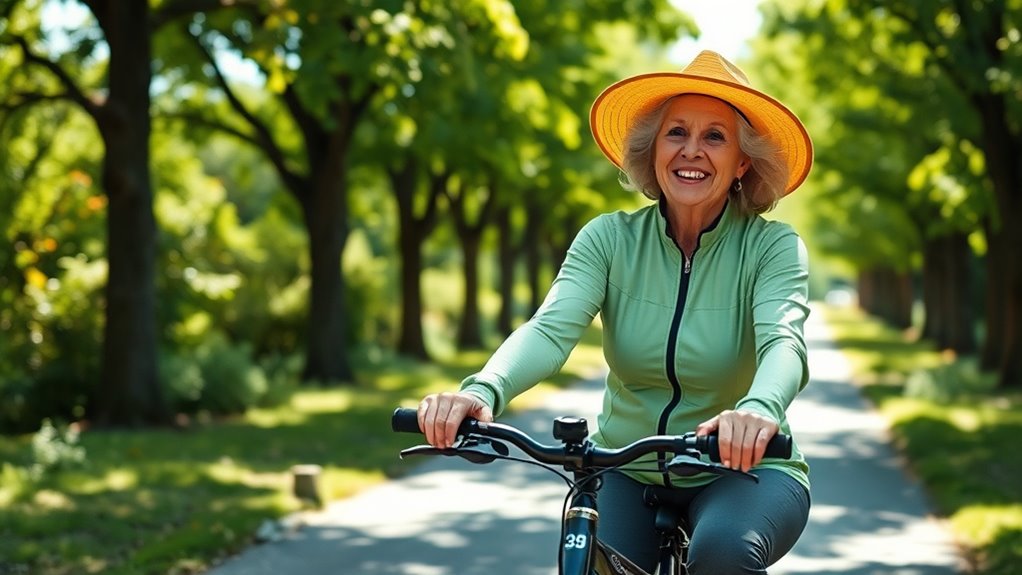
Many seniors face obstacles like fear of falling, limited mobility, or lack of confidence when considering cycling. These challenges can impact your mental health, making you feel isolated or anxious about trying something new.
Fear of falling, limited mobility, and lack of confidence can affect seniors’ mental health and willingness to cycle.
To overcome this, start slowly and choose flat, safe routes to build confidence. Engaging with a community or cycling group can boost your motivation and provide support, helping you stay committed.
Remember, cycling can enhance your mental well-being by reducing stress and improving mood. If mobility is limited, consider adaptive bikes or assistance devices.
Focus on progress rather than perfection. With patience and the right mindset, you can break through barriers and enjoy the many physical and social benefits that cycling offers.
Exploring Local Cycling Routes and Trails
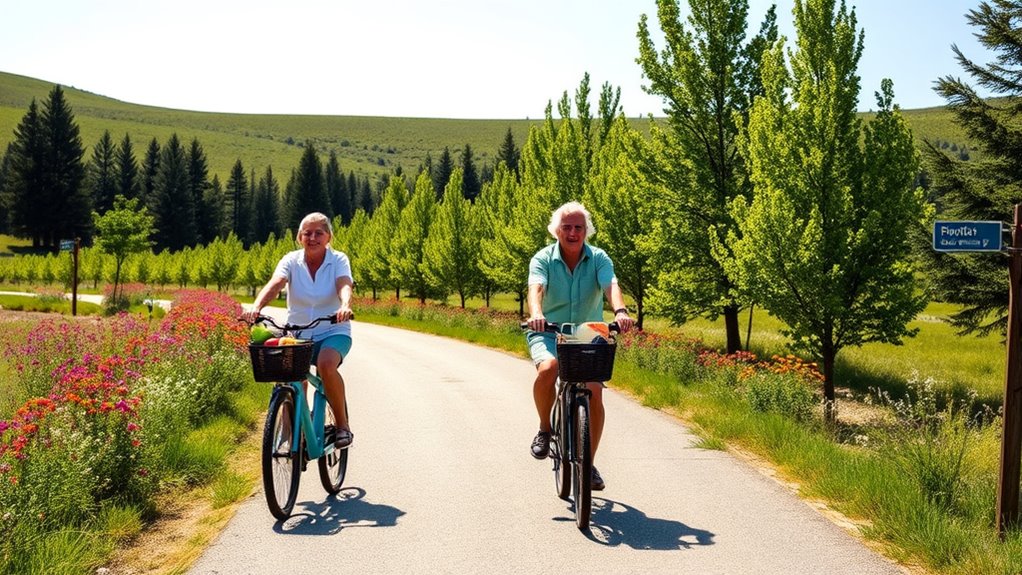
Discovering local cycling routes and trails is a great way to enjoy the outdoors and make your rides more enjoyable. Exploring nearby paths opens up opportunities to see scenic viewpoints and participate in local events. To get started:
- Check out community maps highlighting scenic viewpoints along popular trails.
- Join local cycling groups that organize rides during festivals or special events.
- Visit parks or nature reserves with dedicated bike paths for safe, leisurely rides.
- Discover nearby bike-friendly cafes or rest stops to relax and connect with fellow cyclists.
These routes can boost your confidence, keep your rides interesting, and help you stay motivated.
Plus, they offer a chance to appreciate your local environment and feel more connected to your community.
Social Aspects of Cycling for Older Adults
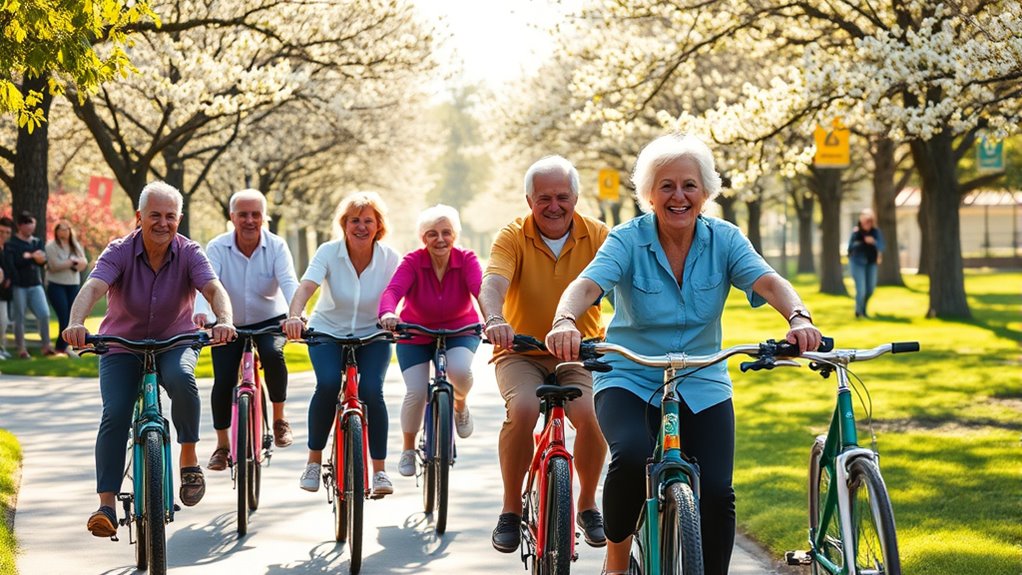
Cycling offers more than just physical benefits; it also provides valuable opportunities for social connection among older adults. Group riding fosters community engagement, helping you build friendships and stay motivated. Joining cycling groups or clubs makes rides more enjoyable and creates a sense of belonging. Whether you’re sharing stories during a break or encouraging each other on challenging trails, cycling strengthens social bonds. To illustrate, consider this comparison:
| Solo Cycling | Group Riding |
|---|---|
| Focus on personal pace | Social interaction |
| Flexibility in schedule | Shared experiences |
| Limited social engagement | Community building |
| Self-motivation | Mutual encouragement |
Engaging in group rides boosts your mental well-being and keeps you connected, making cycling a fulfilling social activity.
Encouraging a Lifelong Love of Riding

Fostering a lifelong love of riding begins with cultivating positive experiences and building confidence at every stage of your cycling journey. To keep that passion alive, focus on key habits:
- Regular bike maintenance guarantees your bike stays safe and reliable, making rides enjoyable and stress-free.
- Practicing good cycling etiquette demonstrates respect for others and creates a friendly riding environment.
- Set achievable goals, like exploring new routes or riding with friends, to stay motivated.
- Celebrate milestones and progress, reinforcing your love for cycling and encouraging ongoing participation.
Frequently Asked Questions
How Can Seniors Prevent Injuries While Cycling?
To prevent injuries while cycling, you should focus on bike maintenance and wearing proper gear.
Regularly check your bike for loose parts and make sure brakes work well.
Always wear a helmet, gloves, and reflective clothing for safety.
Stay alert to your surroundings, ride at a comfortable pace, and avoid risky terrains.
Proper gear and bike upkeep help you stay safe and enjoy your ride without unnecessary injuries.
Are There Specific Cycling Programs for Older Adults?
Imagine your journey as a gentle river meandering through a peaceful landscape. You’ll find many specific cycling programs designed for older adults, focusing on bike safety and proper cycling gear. These programs act as friendly guides, helping you navigate with confidence and ease.
What Should Seniors Do if They Experience Discomfort During Riding?
If you experience discomfort while riding, first verify your bike has a proper fit to prevent pain. Check saddle height, handlebar position, and reach.
If pain persists, focus on pain management strategies—rest, ice, or over-the-counter pain relief.
Don’t ignore discomfort; it’s your body’s signal. Adjust your riding technique or equipment as needed and consider consulting a healthcare professional for personalized advice to stay comfortable and safe.
How Does Cycling Impact Cognitive Health in Seniors?
Think of your brain as a muscle that benefits from regular exercise. Cycling boosts your cognitive health by enhancing mental agility and supporting memory retention, much like watering a garden helps flowers flourish.
As you pedal, you increase blood flow to your brain, which keeps your mind sharp and engaged. This simple activity can help ward off cognitive decline, making you feel more alert, focused, and mentally vibrant in your later years.
Can Cycling Help Manage Chronic Conditions Like Arthritis?
Cycling can help manage chronic conditions like arthritis by providing gentle exercise that promotes arthritis relief and improves joint flexibility.
When you cycle regularly, you strengthen the muscles around your joints, reducing pain and stiffness. It’s a low-impact activity, so it’s easier on your joints compared to high-impact exercises.
Keep a steady pace, and you’ll find cycling a beneficial way to stay active, manage arthritis symptoms, and maintain joint health.
Conclusion
Embracing cycling in your later years can genuinely boost your health and happiness, and recent studies suggest it may even help preserve brain function longer. By choosing the right bike, staying safe, and staying consistent, you’re not just staying active—you’re enriching your life. So, get out there, explore new trails, and enjoy the journey. Cycling proves that age is just a number, and with each pedal stroke, you’re redefining what’s possible at any age.
